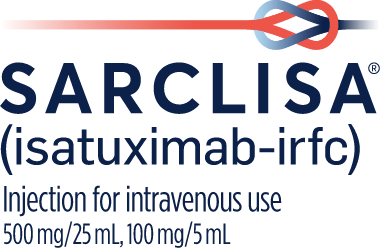CLINICAL TRIAL RESULTS
Trial 1: SARCLISA + Kyprolis® and dexamethasone (Kd) helped patients live progression free longer vs Kd alone
SARCLISA + Kd
Median of
~42
months
VS
Kd alone
Median of
~21
months
LONGEST RESULTS EVER REPORTED
in a Phase 3 trial that included patients who had stopped responding to Revlimid®*
*Based on a review of published Phase 3 trials that included patients with previously treated multiple myeloma who stopped responding to Revlimid (lenalidomide). This information should be interpreted with caution as direct comparisons between different trials cannot be made, and various factors differ between trials. These factors include differences in patient populations and how different treatments work and how they are given, all of which can affect trial results, including treatment effectiveness and possible side effects. Contact your doctor with any questions you have about these results.
At a median follow-up of 44 months, patients lived progression free for a median of 41.7 months with SARCLISA + Kyprolis (carfilzomib) and dexamethasone (Kd) vs 20.8 months with Kd alone. At the time of this analysis, 56% (101 of 179 patients) lived progression free with SARCLISA + Kd vs 45% (55 of 123 patients) treated with Kd alone. In an earlier analysis, at a median follow-up of 20.7 months, 74% (133 of 179 patients) lived progression free with SARCLISA + Kd vs 59% (73 of 123 patients) treated with Kd alone. A median is the middle number in a group of numbers ordered from smallest to largest.
Trial 2: SARCLISA + Pomalyst® and dexamethasone (Pd) helped more patients live progression free vs Pd alone
![In trial 2, around half of patients (53% [81 of 154 patients]) treated with SARCLISA + Pd lived progression free vs 42% (64 of 153 patients) with Pd alone at a median follow up of 11.6 months](/assets/img/clinical-study-results/Trial-2-PFS-graphic.png)
![In trial 2, around half of patients (53% [81 of 154 patients]) treated with SARCLISA + Pd lived progression free vs 42% (64 of 153 patients) with Pd alone at a median follow up of 11.6 months](/assets/img/clinical-study-results/Trial-2-PFS-graphic-mobile.png)
of patients treated with SARCLISA + Pd lived progression free
At a median follow-up of 11.6 months, 53% (81 of 154 patients) lived progression free with SARCLISA + Pomalyst (pomalidomide) and dexamethasone (Pd) vs 42% (64 of 153 patients) treated with Pd alone.
SARCLISA + Kyprolis and dexamethasone: In a clinical trial of 302 patients with previously treated multiple myeloma who had received 1 to 3 prior treatments, 179 patients received SARCLISA + Kd and 123 patients received Kd alone.
SARCLISA + Pomalyst and dexamethasone: In a clinical trial of 307 patients with previously treated multiple myeloma who had received at least 2 prior treatments, including Revlimid and a proteasome inhibitor,† 154 patients received SARCLISA + Pd and 153 patients received Pd alone.
Both trials compared how long patients lived progression free and how patients responded to treatment.
†Examples of proteasome inhibitors include Kyprolis, Ninlaro®, and Velcade®.
The majority of patients responded to SARCLISA combinations in 2 Phase 3 trials
SARCLISA + Kd


responded to SARCLISA + Kd
83% responded to treatment with Kd alone. The difference between SARCLISA + Kd and Kd alone was not statistically meaningful.
SARCLISA + Pd


responded to SARCLISA + Pd
vs 35% who responded to treatment with Pd alone.

